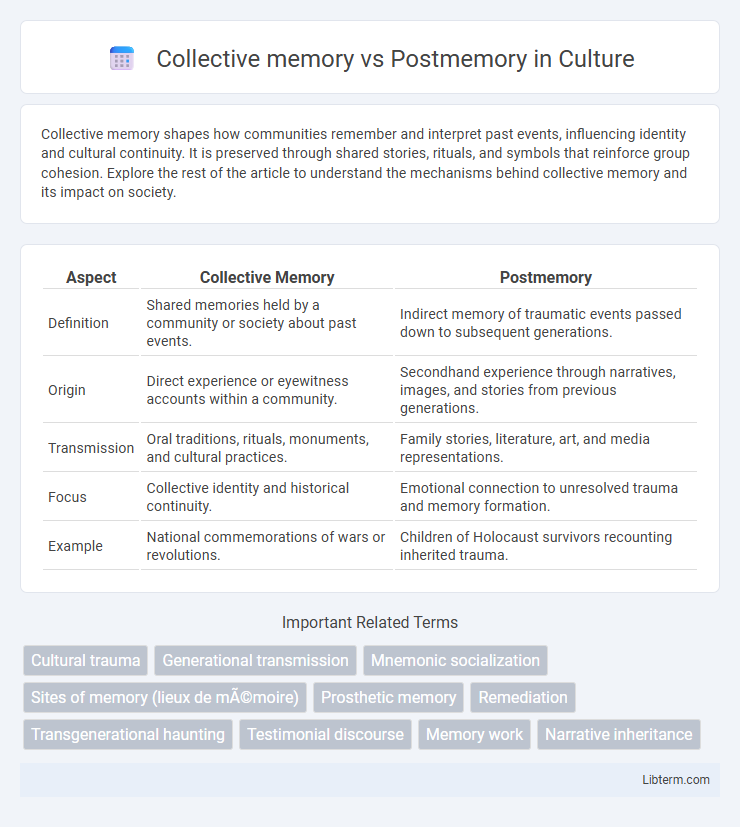Collective memory shapes how communities remember and interpret past events, influencing identity and cultural continuity. It is preserved through shared stories, rituals, and symbols that reinforce group cohesion. Explore the rest of the article to understand the mechanisms behind collective memory and its impact on society.
Table of Comparison
| Aspect | Collective Memory | Postmemory |
|---|---|---|
| Definition | Shared memories held by a community or society about past events. | Indirect memory of traumatic events passed down to subsequent generations. |
| Origin | Direct experience or eyewitness accounts within a community. | Secondhand experience through narratives, images, and stories from previous generations. |
| Transmission | Oral traditions, rituals, monuments, and cultural practices. | Family stories, literature, art, and media representations. |
| Focus | Collective identity and historical continuity. | Emotional connection to unresolved trauma and memory formation. |
| Example | National commemorations of wars or revolutions. | Children of Holocaust survivors recounting inherited trauma. |
Defining Collective Memory: Concepts and Origins
Collective memory refers to the shared pool of knowledge and information held by a group, often shaped by cultural narratives, historical events, and social practices that define group identity over generations. It originates from the work of sociologist Maurice Halbwachs, who emphasized that memory is reconstructed through social frameworks and communal contexts rather than individual recall alone. This concept underpins how societies preserve and transmit collective experiences, contrasting with postmemory, which specifically addresses the inherited memories of trauma experienced by subsequent generations.
Understanding Postmemory: Generational Transmission
Postmemory refers to the transmission of memories from one generation to the next, especially when descendants inherit the traumatic experiences they did not directly live through but profoundly shape their identities. Unlike collective memory, which is shared and constructed by a community or society, postmemory emphasizes personal and familial connections to past events, often conveyed through stories, images, and behaviors. This intergenerational transfer helps descendants process trauma, preserve history, and create meaning from inherited experiences.
Key Differences Between Collective Memory and Postmemory
Collective memory refers to the shared pool of knowledge and information held by a group, often based on direct experiences or historical events, while postmemory describes the relationship of later generations to the traumatic experiences of their predecessors, typically transmitted through stories, images, and behaviors. Key differences include collective memory's basis in lived experience versus postmemory's reliance on mediated and inherited recollections. Collective memory shapes group identity through common participation, whereas postmemory influences individuals who did not directly witness events but are profoundly affected by their legacy.
The Role of Trauma in Shaping Memory Narratives
Collective memory forms through shared experiences within a community, often solidified by historical trauma that shapes group identity and cultural narratives. Postmemory describes how subsequent generations inherit and internalize trauma they did not directly experience, influencing their perception and retelling of past events. Trauma plays a crucial role by embedding emotional and symbolic meanings into memory narratives, affecting both communal recollections and individual connections to history.
Collective Memory in Society: Formation and Function
Collective memory in society involves the shared pool of knowledge and information maintained by a group, shaping a common identity through rituals, narratives, and commemorations. It forms through repeated social practices and cultural transmission, reinforcing social cohesion and providing a framework for understanding history. This collective remembering functions to preserve values, legitimize social orders, and influence collective behavior across generations.
Postmemory and Intergenerational Storytelling
Postmemory refers to the deeply personal yet indirect transmission of traumatic memories from one generation to the next, often experienced by descendants who did not directly witness the original events. Intergenerational storytelling plays a crucial role in shaping postmemory by providing narratives that help descendants understand and emotionally connect with their family's past traumas. This process enables inherited memories to persist, influence identity formation, and foster collective understanding across generations.
Media and Art in Preserving Memory
Collective memory in media and art involves shared narratives and symbols that communities create to remember historical events, while postmemory refers to the inherited memories of trauma passed down to subsequent generations through representation rather than direct experience. Films, visual arts, and digital storytelling serve as powerful tools to bridge these memory forms, enabling audiences to engage with both firsthand accounts and transmitted memories. By preserving cultural identity and fostering empathy, media and art contribute to sustaining and evolving collective and postmemory across time.
Memory, Identity, and Cultural Continuity
Collective memory shapes identity by transmitting shared experiences and cultural values within a community, reinforcing social cohesion and continuity across generations. Postmemory refers to the inherited memories of traumatic events experienced by previous generations, influencing descendants' sense of identity and connection to cultural history despite not directly experiencing those events. Both mechanisms crucially sustain cultural continuity by embedding personal and collective narratives into communal identity frameworks.
Challenges in Representing History Across Generations
Collective memory and postmemory face significant challenges in representing history across generations due to differing experiential proximities to past events. Collective memory relies on shared experiences within a community, while postmemory involves the inherited memories of subsequent generations who did not directly witness the events, often transmitted through family narratives or cultural artifacts. The gap between firsthand experience and transmitted memory complicates accurate historical representation, as postmemory may incorporate emotional interpretation and selective remembrance, impacting the authenticity and continuity of historical knowledge.
Collective Memory vs Postmemory: Implications for the Future
Collective memory shapes group identity through shared experiences encoded in cultural rituals, monuments, and narratives, while postmemory involves the inherited, often indirect transmission of trauma and history to subsequent generations. Understanding the distinction highlights how collective memory anchors societal cohesion, whereas postmemory necessitates new modes of engagement to address fragmented and mediated memories. Future implications emphasize the need for integrative frameworks that honor both direct and inherited memories to foster healing, inclusivity, and intergenerational dialogue in increasingly diverse societies.
Collective memory Infographic

 libterm.com
libterm.com